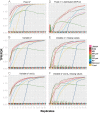Identification of significant features by the Global Mean Rank test
- PMID: 25119995
- PMCID: PMC4132091
- DOI: 10.1371/journal.pone.0104504
Identification of significant features by the Global Mean Rank test
Abstract
With the introduction of omics-technologies such as transcriptomics and proteomics, numerous methods for the reliable identification of significantly regulated features (genes, proteins, etc.) have been developed. Experimental practice requires these tests to successfully deal with conditions such as small numbers of replicates, missing values, non-normally distributed expression levels, and non-identical distributions of features. With the MeanRank test we aimed at developing a test that performs robustly under these conditions, while favorably scaling with the number of replicates. The test proposed here is a global one-sample location test, which is based on the mean ranks across replicates, and internally estimates and controls the false discovery rate. Furthermore, missing data is accounted for without the need of imputation. In extensive simulations comparing MeanRank to other frequently used methods, we found that it performs well with small and large numbers of replicates, feature dependent variance between replicates, and variable regulation across features on simulation data and a recent two-color microarray spike-in dataset. The tests were then used to identify significant changes in the phosphoproteomes of cancer cells induced by the kinase inhibitors erlotinib and 3-MB-PP1 in two independently published mass spectrometry-based studies. MeanRank outperformed the other global rank-based methods applied in this study. Compared to the popular Significance Analysis of Microarrays and Linear Models for Microarray methods, MeanRank performed similar or better. Furthermore, MeanRank exhibits more consistent behavior regarding the degree of regulation and is robust against the choice of preprocessing methods. MeanRank does not require any imputation of missing values, is easy to understand, and yields results that are easy to interpret. The software implementing the algorithm is freely available for academic and commercial use.
Conflict of interest statement
Figures





References
-
- Olsen JV, Blagoev B, Gnad F, Macek B, Kumar C, et al. (2006) Global, in vivo, and site-specific phosphorylation dynamics in signaling networks. Cell 127: 635–648. - PubMed
-
- Storey J (2002) A direct approach to false discovery rates. Journal of the Royal Statistical Society: Series B (Statistical Methodology) 64: 479–498.
Publication types
MeSH terms
Substances
LinkOut - more resources
Full Text Sources
Other Literature Sources
Medical
Miscellaneous

